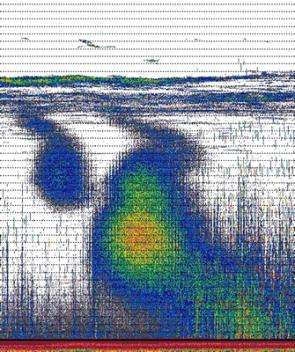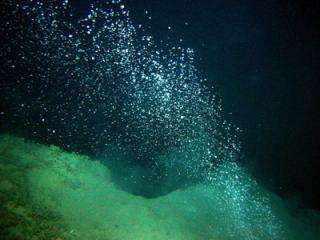Greenhouse gases from the deep sea

Methane from the bottom of the sea contributes more to global warming than previously assumed. Scientists of the Alfred Wegener Institute for Polar- and Marine Research investigated a mud volcano located in the deep-sea between Norway und Svalbard.
Greenhouse gases contribute significantly to present changes of the global climate. Carbon dioxide and methane are major greenhouse gases, whereby methane molecules do 20 times more efficiently prevent reverberation of heat into outer space.

The sources of methane are mostly known in terrestrial areas; however, oceanic emissions are much less investigated. Our knowledge is in particular poor concerning the amount of methane from oceanic sources that reaches the atmosphere. Hitherto scientists assumed that microorganisms almost immediately destroy methane emitted from the sea floor. Under this assumption methane from the deep-sea would have no impact on the climate.
A German-French-Russian cooperation under the leadership of the Alfred Wegener Institute actually found considerable quantities of deep-sea methane going into the atmosphere. Investigating of the active mud volcano Håkon Mosby between Norway and Svalbard, the scientists discovered a plume of methane bubbles 800 metres above sea floor. By means of optical and acoustical observations researchers found a upward water stream induced by the buoyancy of the bubbles. This upward stream transported methane to the ocean surface even beyond the depth of bubble dissolution. Scientists estimate that the Håkon Mosby mud volcano emits some hundred tons methane per year to the upper water column. "The number of submarine mud volcanoes is estimated to several thousands world-wide", explains Eberhard Sauter, geochemist at the Alfred Wegener Institute. "Their contribution to the global methane budget might be important."
Presently scientists develop an acoustical method to quantify the amount of methane discharged in such plumes. This method is hoped to ease detection and characterization of submarine methane sources. Precise data will optimise modelling of future climate development.
The scientific data are published in “Earth and Planetary Science Letters” and constitute a result of the cooperation between the Alfred Wegener Institute and its French partner institute Ifremer under participation of the Max Planck Institute for Marine Microbiology, Bremen and the Institute for Applied Physics at the Russian Academy of Sciences Nizhny Novgorod.
Source: Alfred Wegener Institute for Polar and Marine Research (AWI)


















